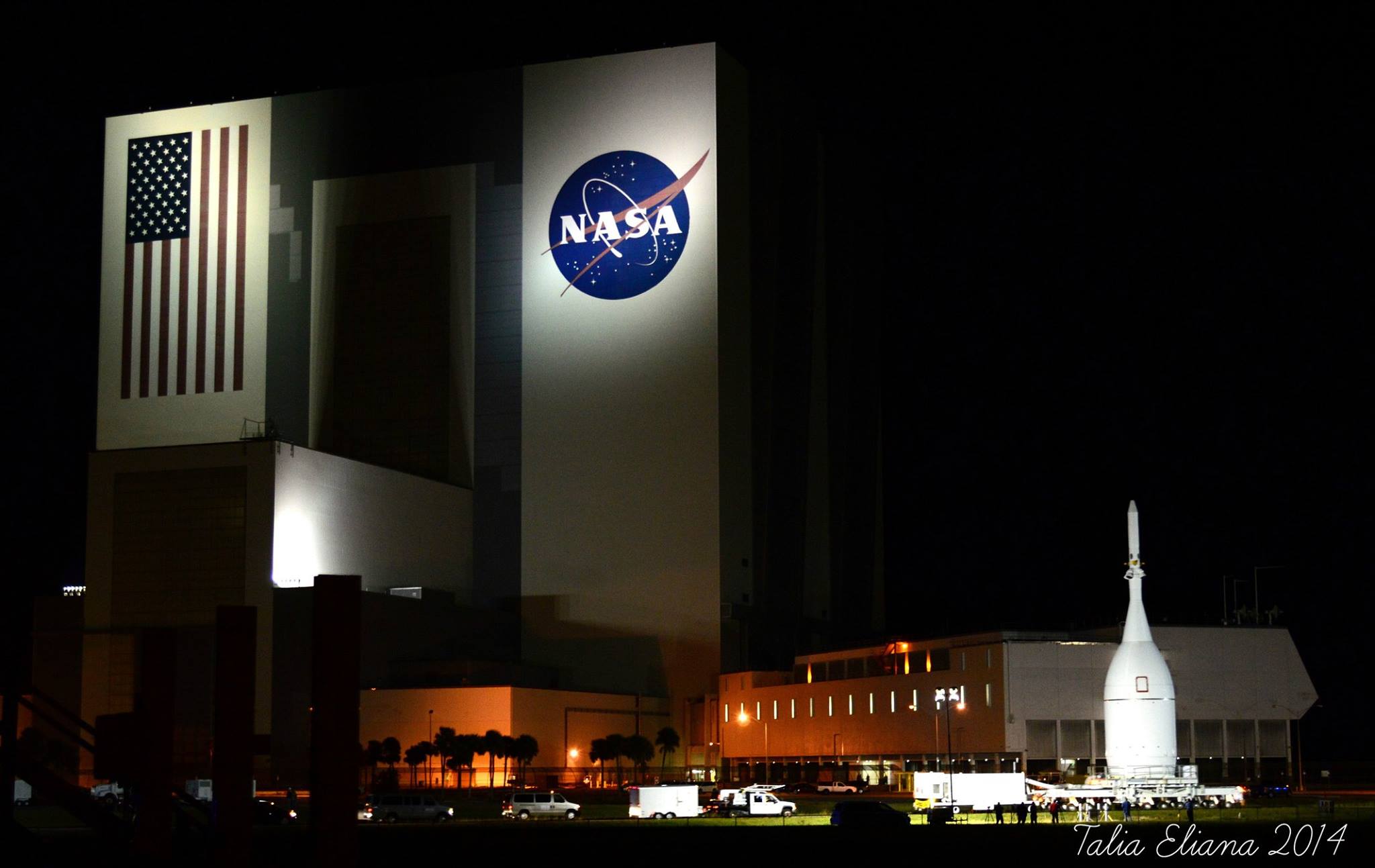
After more than a decade of planning, preparation, frustration and cancellation, in just 11 days’ time the first human-capable vehicle for Beyond Earth Orbit (BEO) exploration in more than four decades will embark on its much-anticipated maiden voyage. Liftoff of NASA’s first Orion spacecraft on the Exploration Flight Test (EFT)-1 mission is targeted to occur from Space Launch Complex (SLC)-37B at Cape Canaveral Air Force Station, Fla., at 7:05 a.m. EST on Thursday, 4 December. Orion will be boosted aloft by the most powerful rocket currently in active operational service, anywhere in the world—the Delta IV Heavy—which is tasked with delivering the two-part spacecraft to a peak altitude of 3,600 miles (5,800 km). It will then complete two orbits in 4.5 hours, before plunging back to Earth in excess of 20,000 mph (32,000 km/h) to test its heat shield at near-lunar-return velocities and temperatures of close to 2,200 degrees Celsius (4,000 degrees Fahrenheit). As noted in yesterday’s AmericaSpace history article, EFT-1 represents nothing less than a quantum leap in preparing to return humans to deep space for the first time since the Apollo era.
The Orion spacecraft consists of two primary components, a conical Crew Module and a cylindrical Service Module, and is designed to eventually support deep-space missions of up to 21 days in duration, plus another six months in “quiescent” mode. The conical shape of the Crew Module was deemed the safest and most reliable means of re-entering Earth’s atmosphere at the extreme velocities required for direct-return trajectory profiles from the Moon and destinations further afield. It stands 10 feet (3.3 meters) tall and measures 16.5 feet (5 meters) across its base, as opposed to 12.8 feet (3.9 meters) for the Apollo command module, thereby providing an interior volume of 690 cubic feet (19.5 cubic meters), significantly larger than its 1960s-era ancestor.
Moreover, the Crew Module is equipped with “smart cockpit” digital controls, derived from the Boeing 787 Dreamliner, which will provide its future crews with enhanced situational awareness. “Whereas the shuttle’s cockpit screens are filled with data that astronauts have to interpret and act upon,” Flight International explained in October 2006, “Orion’s displays will use graphics along with enhanced synthetic vision and additional flight-related symbology.” At the apex of the Crew Module will be the NASA Docking System (NDS), which has compatibility with the two International Docking Adapters (IDAs), to be launched to the International Space Station (ISS) aboard a pair of SpaceX Dragon resupply missions in June and August 2015. Orion’s cabin atmosphere is an oxygen-nitrogen mixture at close to terrestrial sea-level pressure.
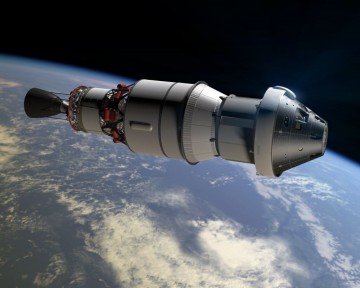
Mounted at the base of the Crew Module is the cylindrical Service Module, which marks out Orion as the first piloted spacecraft in U.S. history—excluding space stations—to carry solar arrays. In the original design, the arrays took the form of two circular panels, deployed from the main body of the Service Module shortly after launch, which would give the spacecraft a total span of about 55.7 feet (17 meters). The Service Module stands 15.5 feet (4.8 meters) in height and measures 16 feet (5 meters) in diameter, with an empty mass of 8,000 pounds (3,700 kg). At its base is the Aerojet-built main engine, capable of 7,500 pounds (3,400 kg) of thrust, with a Reaction Control System (RCS) providing maneuverability and backup capability to execute the critical Trans-Earth Injection (TEI) “burn” from deep space. Inside the bowels of the Service Module, a pair of liquid oxygen tanks and smaller nitrogen tanks will maintain Orion’s habitability, whilst lithium hydroxide cartridges will scrub the crew’s exhaled carbon dioxide with oxygen and nitrogen and recycle them back into the life-support loop. The Service Module for EFT-1 has been fabricated by Lockheed Martin, with batteries in place of solar arrays, although that of the next flight in 2018 will be developed by the European Space Agency (ESA) and will feature an X-shaped layout of four electricity-generating “wings”.
As described in last weekend’s AmericaSpace history articles, the formative years of Orion were a troubled time, mired in political, financial and technical frustration, and by the spring of 2010—six years after President George H.W. Bush first announced the “Crew Exploration Vehicle” (CEV) as part of his Vision for Space Exploration (VSE)—the program was beginning to bear fruit, with Lockheed Martin having been selected as its prime contractor. Parachute tests were serving to validate Orion’s landing system, whilst rocket engine hardware for the powerful Ares I Crew Launch Vehicle (CLV) and Ares V Cargo Launch Vehicle (CaLV) was being steadily matured for service. Elsewhere, in October 2009, a four-segment Solid Rocket Booster (SRB), capped with a “dummy” fifth segment, was successfully test-launched from Pad 39B at the Kennedy Space Center (KSC).
Yet the arrival of Barack Obama in the White House in January 2009 brought a distinctly cooler reception of the VSE, whose overall architecture—the Constellation Program—sought to return astronauts to the Moon no later than 2020 and human exploration of Mars at some stage thereafter. The new president harshly criticized the program as being “over-budget, behind schedule and lacking in innovation” and used the recommendations of the Augustine Commission as the basis for its cancellation in 2010. However, a year later, work on Orion continued in the form of the “Multi-Purpose Crew Vehicle” (MPCV), and in September 2011 welding of its first components got underway, as NASA announced the development of a new superbooster for BEO exploration: the Space Launch System (SLS).
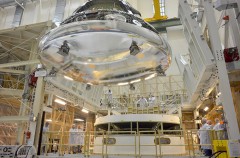
As these plans for the future began to crystallize, Orion itself drew ever closer to its own maiden launch. Parachute testing at the U.S. Army’s Yuma Proving Ground, near Yuma, Ariz., continued throughout 2012, helping to evaluate the influence of the disturbed air flow in Orion’s wake and the effects of improper canopy deployment, and water impact testing took place in the Hydro Impact Basin at the Langley Research Center in Hampton, Va., but from a public relations perspective the major event took place on 2 July, when the actual EFT-1 spacecraft was delivered from the Michoud Assembly Facility in New Orleans, La., to the Kennedy Space Center (KSC), Fla., for final processing. With liftoff atop a United Launch Alliance (ULA) Delta IV Heavy now rescheduled for no earlier than September 2014, the next steps involved the application of heat-shielding thermal protection materials and the installation of avionics and other subsystems onto Orion.
International co-operation had long been courted and on 16 January 2013 NASA signed contracts with the ESA to build the Service Module for Orion’s second voyage—the unpiloted Exploration Mission (EM)-1, destined to travel to the vicinity of the Moon—which will ride aboard the debut flight of the SLS heavy-lift booster, no later than November 2018. This came as little surprise to most observers, since ESA had for at least two years before the announcement expressed interest in using its Automated Transfer Vehicle (ATV) technology as part of the Orion spacecraft. This ATV heritage is obvious in the agency’s evolving schematics for the Service Module. The circular arrays from the original Orion design will be gone on EM-1, replaced instead by an “X-wing” configuration, not dissimilar to the ATV’s own array layout. As long ago as October 2011, NASASpaceflight.com cited sources which described ESA as “serious” about building the SM, and in November 2012 it was reported that the Europeans were prepared to provide it as “payment in kind” for their continued involvement in the ISS program until the end of the present decade.
Certainly, the ATV—which is currently approaching the end of its fifth and final mission—was the lynchpin for ESA’s “barter” agreement with the ISS partners, covering its operating costs aboard the space station through 2017. Costing $600 million per unit to build, a further investment was needed to cover the 2017-2020 timeframe and Germany apparently favored European participation in the Orion program, with ATV technology as the basis of the Service Module, and a successful flight on EM-1 carries every potential that European participation will be sought for subsequent piloted missions thereafter.
Also in January 2013, the process of attaching—by means of no less than 3,000 bolts—the titanium “skeleton” of Orion’s heat shield onto its carbon-fiber skin got underway at prime contractor Lockheed Martin’s Waterton facility in Denver, Colo. At the same time, engineers at NASA’s Marshall Space Flight Center in Huntsville, Ala., began manufacturing two forward and two aft rings, which would be welded to barrel panels to form the adapter to join the EFT-1 vehicle to the Delta IV Heavy. Orion’s landing system progressed through ever more complex and hairy descent scenarios, including one test in February 2013 which saw the capsule land safely on just two of its three main parachutes and another in April which deployed the canopies at a peak velocity of 250 mph (400 km/h). Further tests in spring 2014 evaluated the performance of the system responsible for deploying Orion’s forward bay cover, which must be jettisoned in order for the parachutes to be released. By thus guarding against irregular events, NASA engineers were able to verify that the parachutes, upon which astronauts will soon depend for their lives, are reliable in the event of the most dire contingencies.
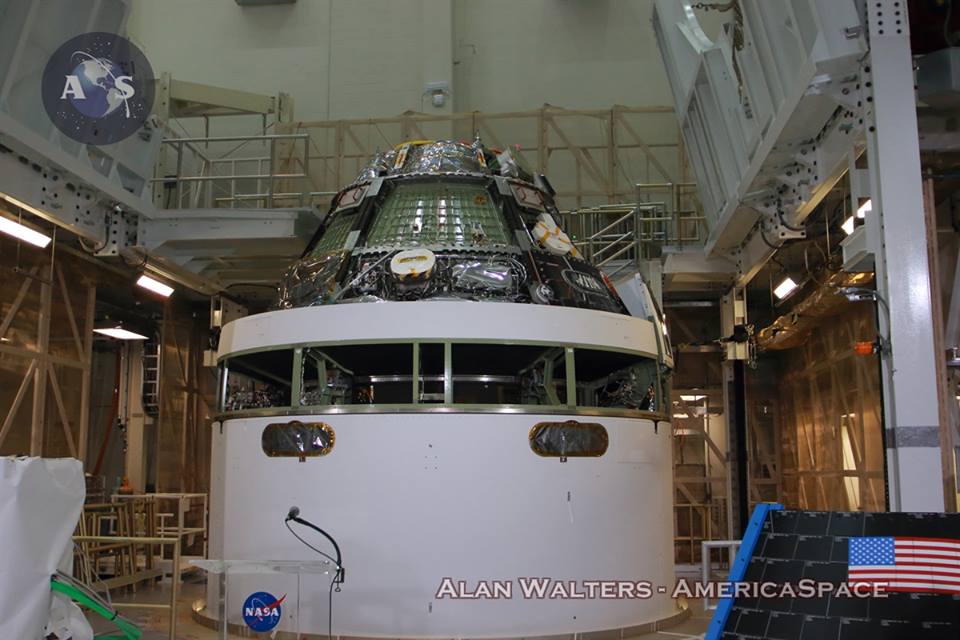
Meanwhile, in KSC’s Operations and Checkout Building, the EFT-1 airframe underwent static loads testing in the first week of June 2013, in which it was subjected to 110 percent of the pressures and loads that it can typically expect during its violent launch into space. These loads ranged from 14,000 pounds (6,350 kg) to as high as 240,000 pounds (108,860 kg) and provided what Charlie Lundquist, NASA’s Orion Crew and Service Module Manager at the Johnson Space Center (JSC) in Houston, Texas, described as “our best method of testing to verify what works on paper will work in space”. During the tests, Orion was pressurized to simulate the effects of near-vacuum, allowing engineers to confirm that it would maintain pressure and verified repairs to superficial cracks in the rear bulkhead, experienced during previous pressure tests.
Throughout the process, NASA astronaut corps—from within whose ranks the first pilots of Orion will be selected, a few years from now—were involved at an intimate level in the spacecraft’s development and testing. In September 2013, ten pairs of astronauts, including Rick Linnehan and Mike Foreman, practiced a range of launch simulations and launch abort scenarios at JSC. “Simulations like these provide valuable experience by giving astronauts and the operations team an early look at what going to deep space in Orion will be like,” explained former shuttle flier Lee Morin, then serving as supervisor of JSC’s Rapid Prototyping Laboratory, with responsibility for the development of the spacecraft’s cockpit displays. “Rehearsing launch and ascent…also gives us an opportunity to work toward optimizing how the crew interacts with the spacecraft.”
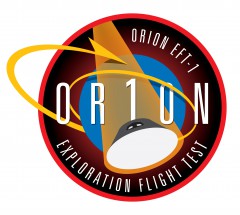
“Power-up” of the EFT-1 vehicle’s main computer for the first time took place in October 2013, with engineers and managers expressing delight as it performed as expected. “It’s been an exciting ride so far, but we’re really getting to the good part now,” said Orion Program Manager Mark Geyer. “This is where we start to see the finish line.” A few weeks later, the separation of payload fairing panels to protect the Service Module during ascent was successfully tested and on the evening of 4 December 2013—exactly a year ahead of the date now established for Orion’s first launch—the completed heat shield arrived at KSC, aboard NASA’s Super Guppy aircraft. After the shield’s titanium skeleton had been fabricated at Lockheed Martin’s Waterton facility, it was shipped to Textron Defense Systems, near Boston, Mass., in March 2013, for installation of a fiberglass-phenolic honeycomb structure, whose 320,000 “cells” were filled with the Avcoat ablator. The entire heat shield was then X-rayed and sanded to match NASA’s design specifications.
This year, 2014, efforts to stage the EFT-1 mission entered high gear. The Orion spacecraft moved swiftly through an integrated systems test in April, during which its myriad components ran for 26 uninterrupted hours in order to verify that the Crew Module could route power and send commands to allow for the management of the computers, software and data loads, propulsion valves, temperature sensors and other instrumentation. Next came Crew Module vibration testing, the installation of the heat shield in May and the stacking of the capsule atop the Service Module on 9 June inside the Final Assembly and System Testing (FAST) Cell in the Operations and Checkout Building.
By this stage, the mammoth Delta IV Heavy, which constitutes the largest and most powerful launch vehicle currently in active operational service, anywhere in the world, was deep into processing for what will be its eighth flight since its maiden voyage, exactly ten years ago, in December 2004. The Heavy was most recently used to launch the NROL-65 classified payload on behalf of the National Reconnaissance Office in August 2013 and during its decade of service has been employed almost exclusively for heavyweight military satellites. The EFT-1 mission marks the vehicle’s first dedicated use for a civilian NASA exploration flight. Capable of delivering up to 63,470 pounds (28,790 kg) into a 125-mile (200 km) low-Earth orbit or up to 31,350 pounds (14,220 kg) into a 22,300-mile (35,900 km) geosynchronous transfer orbit, the Heavy consists of a trio of 134-foot-tall (40.8-meter) Common Booster Cores (CBCs), one of which serves as the first stage “core” and two as side-mounted strap-on rockets. Topping the stack is the 16-foot-wide (5-meter) Delta Cryogenic Second Stage (DCSS) and the dedicated Orion payload fairing, the latter of which successfully underwent structural load tests in January 2014. The entire Heavy weighs an estimated 1.6 million pounds (725,750 kg).
Each CBC carries approximately 440,000 pounds (200,000 kg) of liquid hydrogen and oxygen and each utilizes a single RS-68 cryogenic engine, developed by Pratt & Whitney Rocketdyne. When this engine was introduced back in 2002, it became the first large, liquid-fueled powerplant to be developed in the United States since the Space Shuttle Main Engine (SSME). Hardware for both stages of the Heavy were fabricated by ULA at Boeing’s 1.5-million-square-foot (140,000-square-meter) facility in Decatur, Ala., after which they were transferred to Cape Canaveral Air Force Station, Fla., aboard the M/C Delta Mariner cargo vessel in the February-March 2014 timeframe. Upon arrival at the launch site, the stages underwent final assembly within the seven-story Horizontal Integration Facility (HIF), ahead of rollout to Space Launch Complex (SLC)-37B.
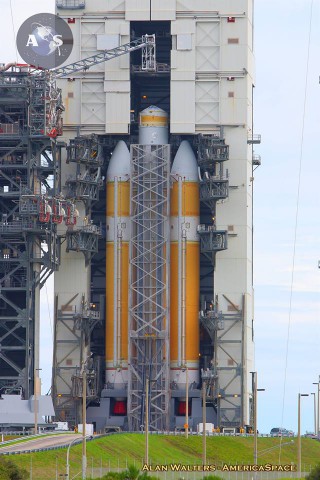
However, it soon became clear that EFT-1 would slip from September to December 2014, due to delays within United Launch Alliance’s (ULA) existing launch manifest. According to an AmericaSpace article by Mike Killian in mid-March, the specific reason was to offer priority to several U.S. military payloads, including the critical Geosynchronous Space Situational Awareness Program (GSSAP)—part of the Air Force Space Command (AFSPC)-4 mission—which eventually launched on 28 July, after many weather-related delays.
Notwithstanding these delays, the protective ogive-shaped panels for Orion’s Launch Abort System (LAS) arrived at the Cape in April 2014. The LAS itself was rotated into a vertical position in late July, ready for the arrival of Orion, which by now was heading into the homestretch of its pre-flight processing regime. The cone-shaped “back shell” of the Crew Module, coated with 970 black protective tiles of shuttle-era heritage, was installed in mid-August. “One of the lesser-known tests…will demonstrate Orion’s ability to operate after sustaining damage from a micrometeoroid hit,” explained Mike Killian at the time. “Orion’s violent return to Earth in December will give engineers the chance to verify new models to better understand the heating environment for damage on Orion’s heat shield, which will inform future decisions about what kind of damage may require a repair. Before installing the protective back shell, engineers purposely drilled 1-inch-wide holes into two tiles on the opposite side of the back shell from Orion’s windows and reaction control system jets. One of the holes is 1.4 inches deep and the other is 1 inch deep, and both are meant to mimic damage from a micrometeoroid hit. Sensors on the vehicle will record how high temperatures climb inside the holes during Orion’s return.” Shortly after the installation of the back shell, the complete EFT-1 spacecraft—Crew Module and Service Module—were moved from the newly-renamed “Neil Armstrong Operations and Checkout Building” to the Payload Hazardous Servicing Facility (PHSF) for fueling. From there, on 28 September, Orion was transferred to the Launch Abort System Facility (LASF) for the installation of the LAS itself.
The Delta IV Heavy was by this stage structurally complete, save its precious payload, and following a 24-hour delay was rolled out from the HIF to SLC-37B by means of the diesel-powered Elevating Platform Transporter on 1 October, whereupon it was hoisted by the Fixed Pad Erector into a vertical orientation within the 260-foot-tall (79.2-meter) Mobile Service Tower (MST). In the meantime, the ogive-shaped panels were installed around the Orion/LAS stack on 30 October, with rollout from the LASF to SLC-37B originally planned for 10 November. This was postponed by 24 hours, due to poor weather, and NASA’s newest spacecraft for human deep-space exploration began its 5 mph (8 km/h) roll to the pad at 8:54 p.m. EST on the 11th. As described by Mike Killian in AmericaSpace’s Photo Feature of the rollout, the EFT-1 stack passed the historic Vehicle Assembly Building (VAB) and Pad 39B en-route, and Orion reached SLC-37B at 3:07 a.m. on 12 November.
Figuratively and literally, it had been a long and tortured journey. Not since December 1972 has a machine capable of carrying human explorers beyond Earth orbit been this close to launch. At its inception in January 2004, the program which spawned the Crew Exploration Vehicle (CEV), later known as Orion, later known as the Multi-Purpose Crew Vehicle (MPCV) and now known as Orion again, was fraught with risk and the ever-present possibility that it might never happen. Memories of President George H.W. Bush’s ill-fated Space Exploration Initiative (SEI), whose enormous price-tag led it to reach Congress virtually stillborn in 1989-1990, pervaded even the most optimistic hopes for the new program. Yet, against all the odds, and in a starkly different fashion from what was originally envisaged, Orion has endured through design, development, into hardware fabrication and testing and is now primed to spear for the heavens. Perhaps this time, America will succeed in returning humans to deep space and establishing itself as a true spacefaring nation.
Perhaps.
With a new president due to occupy the White House in January 2017, the direction of the nation’s space aspirations might change again. However, by that stage, America will have a capability that it has not had since Apollo: a vehicle specifically designed, not with a singular target or rigid goal in mind, but as a multi-faceted machine which may reshape our dreams Beyond Earth Orbit, just as the shuttle did for Low Earth Orbit. Whatever celestial target beckons—whether the Moon, Mars, an asteroid or maybe a waystation or propellant depot at one of the Lagrange Points—the future will brighten significantly on 4 December when the United States takes its next step into the unknown.
“This is the next step on our journey to Mars,” exulted Bill Gerstenmaier, NASA’s Associate Administrator for Human Exploration and Operations. “And it’s a big one!”
This is part of a series of history articles, which will appear each weekend, barring any major news stories. Next week’s article will focus on the Exploration Flight Test (EFT)-1 mission and what it represents for the future of U.S. spaceflight.
Want to keep up-to-date with all things space? Be sure to “Like” AmericaSpace on Facebook and follow us on Twitter: @AmericaSpace
Missions » SLS » Missions » SLS » EFT-1 »


